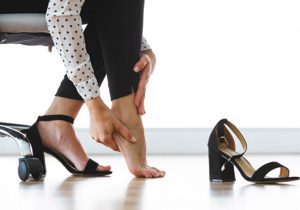By Sean Dunleavy, DPM
Board Certified Ankle and Foot Surgeon and Wound Care Specialist


An example of the aforementioned would be someone purchasing a new pair of running sneakers and then immediately running in them for several miles. Someone might think that there is nothing wrong with this per se, however my recommendation would be for the patient to purchase the new sneakers and wear them in-and-around the house initially doing day to day activities. This does two things, it allows both the feet to get used to the shoes, as well as the shoes to get used to the feet in the sense that the materials will stretch and accommodate somewhat to the shape of the patient’s foot. I also recommend for patients that are doing any sort of extensive running on hard surfaces to do such with an over-the-counter or custom arch supportive insert in the shoes. Regardless if the patient has a high arched foot or a flatfoot, something providing some support and shock absorption will benefit the patient.
Plantar fasciitis is a condition where the insertion or the attachment of the plantar fascia on the bottom of the foot or on the bottom of the heel, becomes irritated, inflamed, and very painful to bear weight. This can happen gradually over time or can happen after an acute event such as a strenuous game of pickle ball, etc. When the patient does develop plantar fasciitis one of the most common descriptions given is a component of post-static-dyskinesia, meaning in layman’s terms “after I do not move, it hurts”. This is why plantar fasciitis causes such a painful condition on the bottom of the heel with the first few steps in the morning when the patient gets out of bed, or after periods of inactivity such as maybe a lunch break where they are sitting down at work, and off of their feet.
The best way to discern plantar fasciitis versus other causes of heel pain is a thorough clinical examination combined with imaging. The imaging could be as simple as an x-ray in the office taken while weightbearing, or an MRI if the pain has been going on for an extended period of time. This information combined with the clinical exam and history from the patient are what we use when determining a diagnosis. A proper diagnosis helps us create the proper treatment plan.
If you or any of your friends or family members think that they may currently have something similar happening, please do not hesitate to give us a call for an appointment. I hope this article motivates you to taking the first steps to getting your heel pain to resolve! (pun intended)
Sean E. Dunleavy, DPM
For more information you may contact Dr. Sean
Dunleavy at Family Foot & Leg Center.
Family Foot & Leg Center has 8 locations through-out Collier, Lee, and Charlotte counties to quickly resolve all your foot and ankle problems.
21401 Corkscrew Village Lane, Suite 4
Estero, FL 33928
(239) 430 – 3668 (FOOT)
www.NaplesPodiatrist.com
 Southwest Florida's Health and Wellness Magazine Health and Wellness Articles
Southwest Florida's Health and Wellness Magazine Health and Wellness Articles

